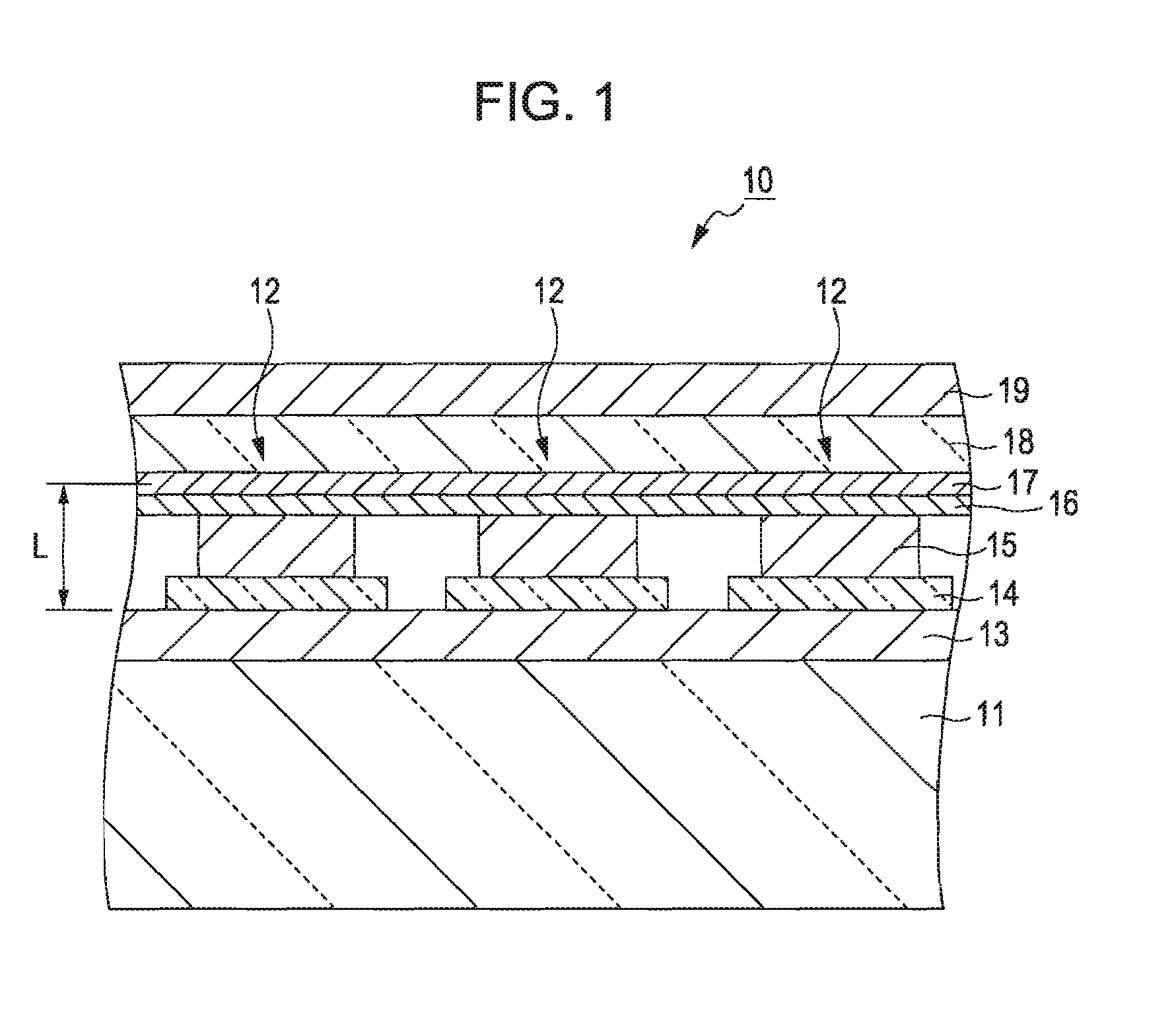Light-emitting device, image forming apparatus, display device, and electronic apparatus
a technology of light-emitting devices and display devices, which is applied in the direction of organic semiconductor devices, electroluminescent light sources, electric lighting sources, etc., can solve the problems of top-emission-type light-emitting devices, large damage to light-emitting layers, and application of techniques
- Summary
- Abstract
- Description
- Claims
- Application Information
AI Technical Summary
Problems solved by technology
Method used
Image
Examples
first embodiment
[0079]FIG. 1 is a cross-sectional view illustrating a part of a light-emitting device 10 according to a first embodiment of the invention. The light-emitting device 10 has a plurality of light-emitting elements 12 arranged on a substrate 11. In FIG. 1, only three light-emitting elements 12 are shown. Each of the light-emitting elements 12 is an organic EL element, that is, an OLED (organic light-emitting diode) element. That is, the light-emitting device 10 is an organic EL device.
[0080]The substrate 11 is formed of a glass, for example, and the thickness of the substrate 11 is 500 μm, for example. On the substrate 11, a light reflection layer 13 from which light is totally reflected is formed. The light reflection layer 13 allows light to resonate and is formed of a material having a high optical reflectance. In addition, an upper surface of the light reflection layer 13 is smooth and the thickness of the light reflection layer 13 is 200 nm, for example. Specifically, the material ...
second embodiment
[0101]FIG. 14 is a cross-sectional view illustrating a part of a light-emitting device 20 according to a second embodiment of the invention. The second embodiment is different from the first embodiment in that a full color image can be displayed. The light-emitting device 20 is suitable for display of a full color image and has a plurality of pixels arranged in a matrix on a light reflection layer 23. Each of the pixels includes a light-emitting element 22R that emits ‘R’ light corresponding to a color close to a red color, a light-emitting element 22G that emits ‘G’ light corresponding to a color close to a green color, and a light-emitting element 22B that emits ‘B’ light corresponding to a color close to a blue color. Although the light emitting elements 22R, 22G, and 22B are described as emitting red color, green color, and blue color, respectively, it should be noted that elements that emit light near to these colors could be used instead.
[0102]The configuration below the light...
third embodiment
[0115]FIG. 23 is a cross-sectional view illustrating a part of a light-emitting device 50 according to a third embodiment of the invention. The third embodiment is different from the first embodiment in that a transparent layer is provided between the light reflection layer 13 and the transparent electrodes 14. The light-emitting device 50 has a plurality of light-emitting elements 52 arranged on a substrate 51. In FIG. 23, only three light-emitting elements 52 are shown. Each of the light-emitting elements 52 is an organic EL element, that is, an OLED (organic light-emitting diode) element. That is, the light-emitting device 50 is an organic EL device.
[0116]The substrate 51 is formed of a glass, for example, and the thickness of the substrate 51 is 500 μm, for example. On the substrate 51, a light reflection layer 53 from which light is totally reflected is formed. The light reflection layer 53 allows light to resonate and is formed of a material having a high optical reflectance. ...
PUM
 Login to View More
Login to View More Abstract
Description
Claims
Application Information
 Login to View More
Login to View More - R&D
- Intellectual Property
- Life Sciences
- Materials
- Tech Scout
- Unparalleled Data Quality
- Higher Quality Content
- 60% Fewer Hallucinations
Browse by: Latest US Patents, China's latest patents, Technical Efficacy Thesaurus, Application Domain, Technology Topic, Popular Technical Reports.
© 2025 PatSnap. All rights reserved.Legal|Privacy policy|Modern Slavery Act Transparency Statement|Sitemap|About US| Contact US: help@patsnap.com



